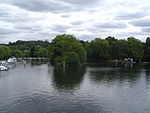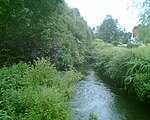Cliveden (pronounced ) is an English country house and estate in the care of the National Trust in Buckinghamshire, on the border with Berkshire. The Italianate mansion, also known as Cliveden House, crowns an outlying ridge of the Chiltern Hills close to the South Bucks villages of Burnham and Taplow. The main house sits 40 metres (130 ft) above the banks of the River Thames, and its grounds slope down to the river. There have been three houses on this site: the first, built in 1666, burned down in 1795 and the second house (1824) was also destroyed by fire, in 1849. The present Grade I listed house was built in 1851 by the architect Charles Barry for the 2nd Duke of Sutherland.
Cliveden has been the home to a Prince of Wales, two Dukes, an Earl, and finally the Viscounts Astor. As the home of Nancy Astor, wife of the 2nd Viscount Astor, Cliveden was the meeting place of the Cliveden Set of the 1920s and 30s—a group of political intellectuals. Later, during the early 1960s when it was the home of the 3rd Viscount Astor, it became the setting for key events of the notorious Profumo affair. After the Astor family stopped living there, by the 1970s it was leased to Stanford University, which used it as an overseas campus. Today the house is leased to a company that runs it as a five-star hotel.
The 375 acres (152 ha) gardens and woodlands are open to the public, together with parts of the house on certain days. Cliveden was one of the National Trust's most popular pay-for-entry visitor attractions, hosting 524,807 visitors in 2019.










